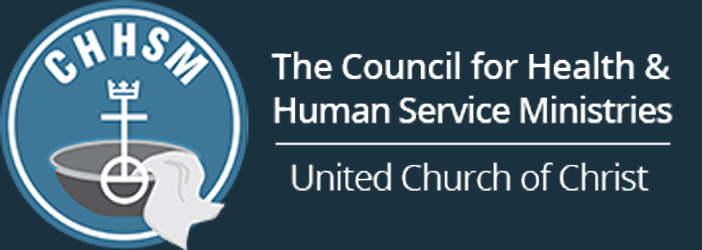Fairhaven Senior Services Heralds Return of the Monarchs
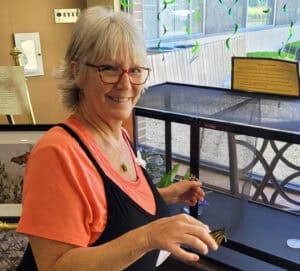
For residents and staff at Fairhaven Senior Services in Whitewater, Wis., the annual migration of Monarch butterflies, with their bright orange and black markings, from Mexico to the United States and Canada is a welcome sight. Once a plentiful sight during the summer months, the Monarchs’ numbers have dwindled in recent years due to the elimination of their natural habitat — milkweed plants. Fairhaven is doing its part to change that.
The Monarch Project is the brainchild of Tena Engels, Fairhaven’s receptionist and unit clerk. “I have been fostering Monarchs for nine years, and it never gets old,” she said. “Last year was the first year I introduced fostering to the folks at Fairhaven — and it was a huge success!”

Engels adds that staff and residents visited the butterflies often. Last year, “we even had ladies come every evening to say goodnight!” she said.
The first indoor habitat for the Monarchs was a 10-gallon fish tank with a removable screen top that sat in Fairhaven’s lobby. In 2023, Fairhaven released 35 Monarchs — 12 female and 23 male — into the natural milkweed areas on the Fairhaven campus.
“I loved it!” said resident Dottie Koenitzer. “I’d come every morning to see what was going on. And we’d talk about it at meals.”
Resident Ginger Mayer even has special butterfly print pants that she’s wearing now that the butterflies have started to arrive in Wisconsin. “I loved them, and I’m looking forward to the new habitat,” she said.
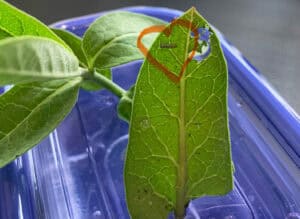
That new habitat — an 18” x 18” x 20” screened habitat gifted by the Friends of Fairhaven — will create a more comfortable safe habitat for the Monarchs as they hatch and grow.
The process takes about a month. The Monarchs lay eggs on milkweed plants, and the eggs are brought into the habitat on the leaves on which they are found. Once in the habitat, the eggs stay on the milkweed for between three and eight days, until the caterpillars hatch. The caterpillars will only feed on milkweed. The future Monarchs molt five times, growing 2,000 times larger in a 10-to-17-day period.
“The final shedding creates the beautiful green and gold chrysalis known exclusively to the Monarch,” said Engels. During the 10-to-15 days following the formation of the chrysalis, “the magical transformation into the orange and black beauty” takes place.
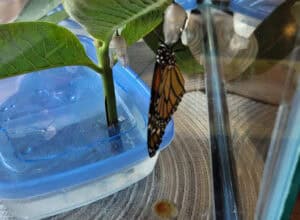
The butterfly emerges from the chrysalis with wet wings. Engels keeps the butterfly in the indoor habitat for 24 hours until the wings are dry and safe for flying, and then gently places them on one of the many flowers in Fairhaven’s garden. The new Monarchs find the milkweed fields and lay more eggs.
“I loved them,” said Fairhaven resident Donna Bieschke. “I tried to catch one outside and couldn’t, but I could see them up close in the habitat.”
An interesting fact, said Engels, is that “the Monarchs born in late spring and most of the summer only live two-to-six weeks — long enough to deposit around 400 eggs. The Monarchs that hatch in late August and early September are built for the long trek to Mexico, where they live for up to eight months.”
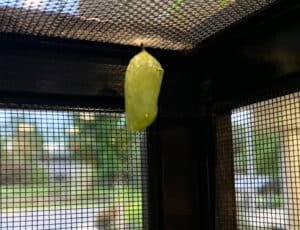
This year’s new habitat — assembled over Mother’s Day weekend — already has five inhabitants at various stages of development. On May 29, the first green and gold chrysalis formed. The first butterfly was born June 7. As of this writing, there are three chrysalis and four tiny caterpillars in the indoor habitat. Once indoor habitat space becomes available, Engels and her volunteers will scour the milkweeds for new eggs to bring in to the lobby enclosure.
“The eggs are about the size of a flathead pin,” she said. “I go out and regularly check the milkweed here on campus. I’ve been known to pull over when I see milkweed along the side of the road and search. There are also a few of my co-workers who have been bitten by the bug, and keep an eye out for eggs.”
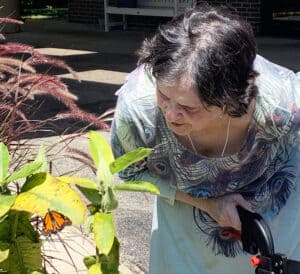
Interestingly, over millenia, the Monarch butterfly has been tied to a variety of similar cultural and spiritual beliefs. Often seen as a sign of rebirth and transformation, the huge throngs of thousands that arrive in Mexico each year symbolize the return of the souls of ancestors. The Mexican migration coincides with the Day of the Dead, a celebration of loved ones who have passed away. Additionally, Monarch butterflies are sacred to Indigenous peoples on both U.S. an Mexican sides of the border.
A bit of that spiritual impact is noticed by Fairhaven resident Merry Fitz-Randolph. “Seeing the butterflies brought back wonderful memories with my husband,” she said. “Watching them flit away made me want to go with them. And watching the Monarchs go through the changes gives me courage. It’s like the Lord is saying, ‘Don’t worry. I’ve got this.’”
This year’s Monarchs will depart for Mexico in the fall. Next spring, the whole cycle will begin again, and Engels and the volunteers will be ready to welcome new winged visitors back to Wisconsin.

In Canada, the Monarchs will be listed as endangered this year. In the United States, the Monarchs plight was reviewed, but the Monarch was not listed on the Endangered Species Act due to the number of other animal species with higher priority ranking. The list is reviewed annually by the U.S. Fish and Wildlife Service.
However, in 2023, the U.S. Fish and Wildlife Service did classify the milkweed plant as endangered. Pesticides and construction have caused the depletion of the crucial plant.
“Sadly, the natural habitats for the Monarch have been greatly depleted in the past, but … we are hoping to make a difference in their longevity,” Engels said.
Special thanks to Tena Engels and Fairhaven Senior Services for the photos.
Join Our Mailing LIst
"*" indicates required fields
